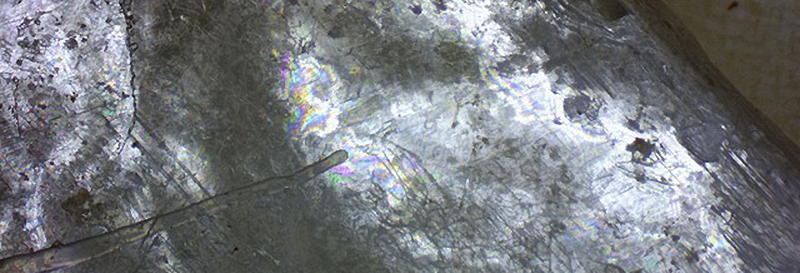Specularia
The term specularia, is often used to describe a small genus of annual herbs, however it can also be used in reference to the Latin meaning of letting light in or transparency. Lapis specularis is also used to describe the selenite crystal form of gypsum (selenitic) that forms in thin sheets. Specularis might be used to describe to a mirroring quality. Other references refer to specularium as the Latin nominative case to mean a window-pane, transparency, or a piece of glass letting through light into a building (specularum, also has historical references to a watchtower or light house).
Specularia appears in two surviving Roman texts: Historia Naturalis, referenced by the Roman agricultural savant Pliny the Elder who describes “beds mounted on wheels which they moved out into the sun and then on wintry days withdrew under the cover of frames, glazed with transparent stone or mica to provide fruits of cucumis.” The second De Re Rustica (On Agriculture) by Columella goes further recommending siting near buildings for wind protection and warmth for the beds.
Many years later in the 1500's the purpose of these devices was described; “The young plants may be defended from cold and boisterous windes, yea, frosts, the cold aire, and hot Sunne, if Glasses made for the onely purpose, be set over them, which on such wise bestowed on the beds, yeelded in a manner to Tiberius Caesar, Cucumbers all the year, in which he took great delight...” (Thomas Hill, “The Gardener’s Labyrinth”, 1577).
In 2010 in the paper; What the Roman emperor Tiberius grew in his greenhouse and in 2022 article History of Controlled Environment Horticulture: Ancient Origins both by H.S. Paris and J. Janick, it is argued that it was actually melons (Cucumis melo) that were grown, ones that lacked sweetness, rather than cucumbers (Cucumis sativus) as described by Hill, describing more specifically the details and other varieties of plants grown in these early greenhouses.
In any case the purpose of these greenhouses was to prolong the growing season for the crop which according to Pliny “a delicacy for which the Emperor Tiberius (reigning from 42 BCE-37 CE), had a remarkable partiality; in fact there was never a day on which he was not supplied it.” Other references talk of specularium and specularia as buildings or early green houses made on the same principles, just static, though this is not clear in history, even if the material was.
The material used is sometimes described as being mica, which is any of the group of hydrous aluminosilicate minerals which form in layers, more specifically it is likely to have been Lapis Specularis the form of Selenite or naturally pure crystalline gypsum. Selenite crystals form in large flat, transparent crystals, often called plates or windows and although at this time the Romans were able to produce glass it was not developed enough for panes as such and only used for small jewellery items and beads. It was around 100AD that Romans, by then adept at glass blowing, started to blow flattened glass tubes, which were then effectively cut in half to create the first window panes.
[edit] Related articles on Designing Buildings
- Botanical gardens
- Biomes.
- Building an extension.
- Conservatory.
- Garden greenhouse.
- Hydroponics and buildings.
- Selenite.
- Satin spar.
- The secret life of the Georgian garden.
- Types of glass.
- Winter gardens.
[edit] External References
Featured articles and news
Retrofit 25 – What's Stopping Us?
Exhibition Opens at The Building Centre.
Types of work to existing buildings
A simple circular economy wiki breakdown with further links.
A threat to the creativity that makes London special.
How can digital twins boost profitability within construction?
The smart construction dashboard, as-built data and site changes forming an accurate digital twin.
Unlocking surplus public defence land and more to speed up the delivery of housing.
The Planning and Infrastructure Bill
An outline of the bill with a mix of reactions on potential impacts from IHBC, CIEEM, CIC, ACE and EIC.
Farnborough College Unveils its Half-house for Sustainable Construction Training.
Spring Statement 2025 with reactions from industry
Confirming previously announced funding, and welfare changes amid adjusted growth forecast.
Scottish Government responds to Grenfell report
As fund for unsafe cladding assessments is launched.
CLC and BSR process map for HRB approvals
One of the initial outputs of their weekly BSR meetings.
Architects Academy at an insulation manufacturing facility
Programme of technical engagement for aspiring designers.
Building Safety Levy technical consultation response
Details of the planned levy now due in 2026.
Great British Energy install solar on school and NHS sites
200 schools and 200 NHS sites to get solar systems, as first project of the newly formed government initiative.
600 million for 60,000 more skilled construction workers
Announced by Treasury ahead of the Spring Statement.
The restoration of the novelist’s birthplace in Eastwood.
Life Critical Fire Safety External Wall System LCFS EWS
Breaking down what is meant by this now often used term.
PAC report on the Remediation of Dangerous Cladding
Recommendations on workforce, transparency, support, insurance, funding, fraud and mismanagement.
New towns, expanded settlements and housing delivery
Modular inquiry asks if new towns and expanded settlements are an effective means of delivering housing.


























Comments
[edit] To make a comment about this article, click 'Add a comment' above. Separate your comments from any existing comments by inserting a horizontal line.